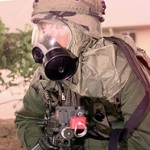Dale Wilson, CIH, LEED AP
When the National Weather service issues a forecast calling for 3 to 4 inches of rain, most people react by wondering how it will affect their plans or travel. I think about what water damage will occur.
When heavy rains are forecast, are you ready? Do you know what to do if your building is affected by rain penetration through the roof or walls? What is your plan if your building is flooded by a local stream or river? Even without bad weather, water damage is always a possible threat if your building has a water line break. Or worse yet, do you know how to react if theres a sewage back-up?
Depending on the water source your options for cleaning up and salvaging property vary greatly. But for all kinds of damage, you need to have a plan in place anticipating what you will do, who you will call, and how quickly they will respond. Emilcott was recently asked to work in four, very different, water-damaged commercial and/or multi-tenant residential properties. These events included:
- Retail and Office Complex Roof and Façade Leak
- Office and Warehouse Broken Water Supply Main
- Multi-tenant Apartment building Sprinkler Activation
- Public Housing Complex Steam Leak
What did all four projects have in common? The answer is time. Lots of time! Too much time between the initial event, the response and
Emilcotts resulting late involvement! Time and water combined can grow to be an expensive and time-consuming enemy. Failure to respond promptly will, very likely, result in mold growth within the building requiring significantly more demolition than if the condition is handled in a timely manner. What is the definition of timely? As soon as it is discovered!
With the retail complex, we were called in approximately one month after the roof and walls began leaking. An employee actually complained to their nearest OSHA office and OSHA issued a notice of potential violation to the employer. Mold was present in a localized area of the store, along with a significant insect infestation due to wet, damp conditions of building surfaces. Unfortunate results of the delay: a mold remediation project was required and portions of the retail space were out of use for weeks.
The damage to the office and warehouse operation was more significant. Water from the broken water main filled the 5400 sq. ft. office to several inches and made its way to the adjacent warehouse. The initial response by the building owner seems logical: removal of standing water, placement of a few box fans to attempt to dry the carpet, and operating the air conditioning 24/7 as cold as the occupants would tolerate. By the time we arrived just 5 days after the event, sheetrock walls were saturated at the base of every wall and elevated moisture readings were present up to 8 feet above the floor. Relative humidity was close to 70%, carpets had a strong musty odor, and internal wall cavities were impacted by mold growth even though no visible growth was observed on the exterior of the wall. Final results of a mere 5 day delay in appropriate responsiveness: the tenant and their sub-tenants loss use of the office area as trailers were brought in to house them while remediation and reconstruction occurred over a two week time period.
A kitchen fire occurred in the residential apartment complex triggered sprinklers to turn on which caused water to run from the sixth floor down to ground level. Removal of standing water was the only initial response. When Emilcott arrived 2 weeks later sheetrock walls were still saturated with water, visible mold was appearing in multiple, occupied apartments, and paint was bubbling and peeling from the walls. Another significant mold remediation project was required, which in turn required relocation of tenants while remediation was in progress.
Finally, the public housing complex had experienced a steam leak for a period of several months. Tenants in effected units were relocated and those apartments remained unoccupied. However, an unusual occurrence happened with this steam leak as these apartments had plaster walls. Mold grew quite well on the painted surface of the walls, something that may be expected, but due to high, high humidity and moisture levels in the plaster for extended periods of time, the analytical laboratory verified that the mold growth penetrated into the plaster from the surface. This resulted in the demolition of the plaster walls and loss of effected housing units for several additional months.
For each of these properties and water-related circumstances, delayed and improper response increased the magnitude of the problem resulting in increased time that each space was unusable, and increased the total cost of response and repair. What should you do instead? Bringing in a water-remediation expert immediately to identify the scope of the problem, develop a water response action plan, and implement that plan right away will minimize the damage to building materials and reduce impacts to building occupants. In each of the four instances listed above, response actions like relocating furnishing away from walls or out of the area completely, immediately removing cove moldings, installing commercial grade dehumidification equipment, installing commercial grade floor fans, selective limited demolition, and actively monitoring and evaluating the drying process would have significantly reduced the duration of the response activity and the overall cost of each event.
So, how can you reduce the costs of the surprise water problem? My advice is to plan now -- whether it is for rain and flooding that may occur due to weather conditions or for the pipe break that always happens unexpectedly. Knowing who to call to determine the scope of the problem and who can implement the recommended response will save you significant time, money, property and hassle.












